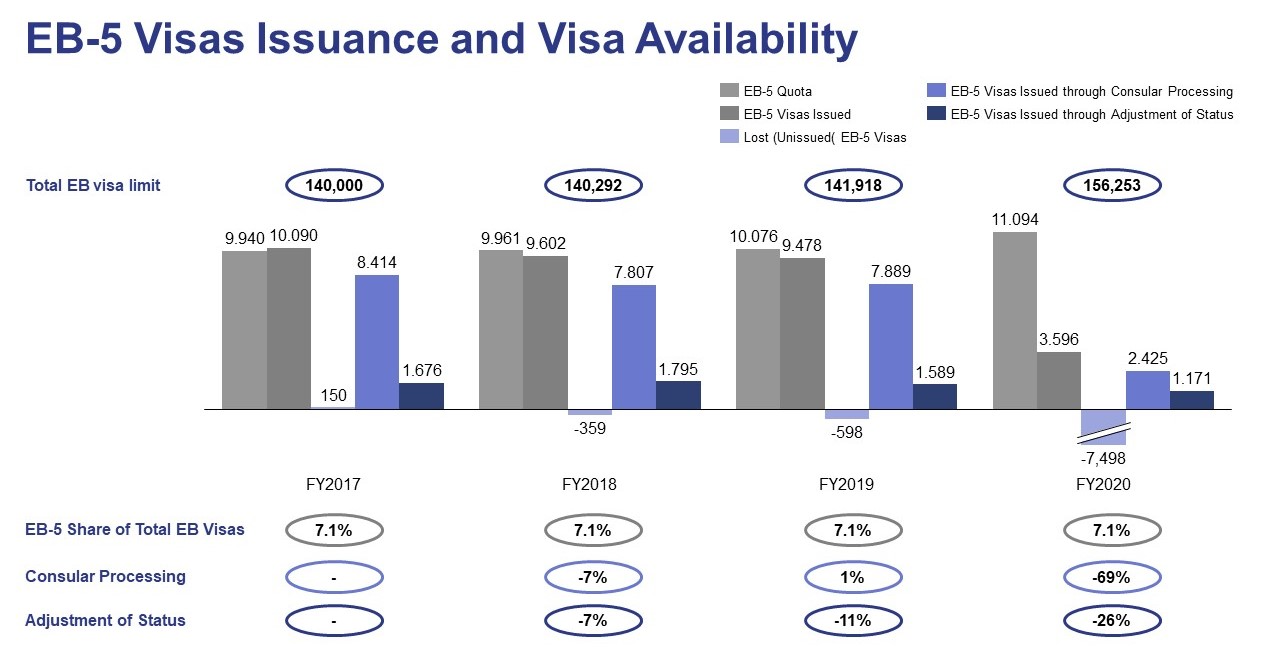2020 was not a good year for many people, as most were confined to their homes indefinitely and public life completely shut down. EB-5 Immigrant Investor Program participants also found themselves affected by the pandemic: lockdowns and border closures affected many who were in the queue to receive U.S. green cards, as U.S. consulates and embassies temporarily ceased routine visa services. United States Citizenship and Immigration Services (USCIS) also closed its offices to investors in the pandemic’s early stages, and the Trump administration introduced a year-long ban on most types of employment-based immigration. Put simply, 2020 was a bad year for foreign nationals looking to permanently immigrate to the United States.
Country-based statistics of EB-5 visa issuances typically offer insight into the share of a country’s investors who opt for EB-5 regional center investment, the countries with the highest demand for the EB-5 investment program, and the number of each country’s EB-5 investors who obtained their EB-5 visa through domestic adjustment of immigration status as opposed to overseas consular processing.
However, for 2020, the statistics just reflect those lucky enough to obtain U.S. permanent residency status despite the pandemic’s shutdowns and processing bottlenecks.
Adjustment of Status EB-5 Visas Issued

As consular processing was effectively ceased for much of 2020, USCIS had far more resources to focus on I-485 petitions. Charles Oppenheim, chief of the Visa Control and Reporting Division at the U.S. Department of State, declared in November 2020 that there were 2,500 pending I-485 petitions from Chinese applicants alone.
Theoretically, USCIS could have processed many pending I-485 petitions to use as many of the EB-5 investment program’s allocated visas as possible. Instead, the immigration body did not even meet FY2019’s number of adjudicated adjustment of status petitions.
USCIS increased I-485 processing for Chinese and Indian nationals, but only marginally. Brazil experienced a massive drop from 214 in FY2019 to a mere 36 in FY2020, and though most other countries didn’t see such a steep drop, they all saw decreases. The total number of FY2020’s adjustment of status EB-5 visas was lower than each of the three preceding fiscal years, with this figure down 26% from FY2019. Although FY2020’s percentage of adjustment of status visas across all EB-5 visas was higher than previous years, this was simply a reflection of FY2020’s number, which was also small.
Why didn’t USCIS adjudicate more adjustment of status EB-5 visas in FY2020, given that consular visas were almost impossible to grant? Oppenheim’s remark suggests that there was not a drop in demand. Instead, it appears that USCIS’ slow processing speed, which extends to most petitions associated with the EB-5 program, is to blame, with the small number of Chinese investors receiving visas due to slow Visa Bulletin movement. However, these abysmal figures cannot be solely attributed to the pandemic, as the number of issued EB-5 investment visas has consistently decreased since FY2018.
Massive Drop in Overall EB-5 Visa Issuance

The pandemic’s effect on the EB-5 program is shown in the overall number of issued EB-5 visas. Although the EB-5 investment program had more than 11,000 earmarked visas in FY2020—higher than the three previous fiscal years—the program issued little more than 3,500 visas, wasting almost 7,500. I-485-based visa issuance fell by 26% to around 1,100, while EB-5 visas issued through consular processing dropped 69% to around 2,400 visas. The loss of 7,500 visas was partially offset by a visa increase in early FY2021, when unused family-based visas were allocated to the EB programs. However, the pandemic’s continued presence as of March 2021 questions whether those EB-5 visas will be granted in FY2021.
EB-5 Visa Issuance in FY2020 by Country


The trend of Chinese EB5 investment participants topping the country list continued in FY2020. FY2020 saw Chinese investors claim more than 46% of all EB-5 visas. Vietnam and India also claimed for sizeable portions, at 13% and 17%, respectively, with South Korea next at just 4% of all visas claimed.
The trend of most EB-5 investment participants choosing to make their investment through a regional center has also continued, with 91% of those who received an EB-5 visa in FY2020 having made their EB-5 investment through a regional center. In all, 15 countries had more than 20 EB-5 visas in FY2020. Two—Japan and Mexico—didn’t see even one direct investor. Other countries, like the UAE or Russia, had only two. Interestingly, Iran had many direct investors, with 14 out of 54 Iranian investors having made their EB5 investment directly.
The breakdown of visa issuance through adjustment of status petitions versus consular processing is also interesting. Although consular processing was totally shutdown throughout half of FY2020, it still represented more than half of the 15 major EB-5 countries EB-5 visa issuances, with the exception of Venezuela. Iran’s consular processing was 96% of all EB-5 visa issuances, which suggests that virtually no Iranian nationals went on to receive an EB-5 visa in the second half of FY2020. Although USCIS was unable to issue consular processing EB-5 visas for a substantial period, the agency did not dole out increased numbers of adjustment of status EB-5 visas.
FY2020 saw approximately 2,400 EB-5 visas issued through consular processing. These visas were likely distributed between October 2019 and February 2020, before the COVID-19 pandemic’s shutdowns. If USCIS had continued to process visas at the same pace, the yearly total would have only been roughly 5,000 visas, with perhaps another 1,500 coming from approved I-485 petitions. This total of approximately 6,500 visas would still have been lower than any of the three years preceding FY2020. This indicates that the EB-5 investment program still suffers from long-standing issues that EB-5 investment stakeholders will have to cope with after the pandemic passes.





